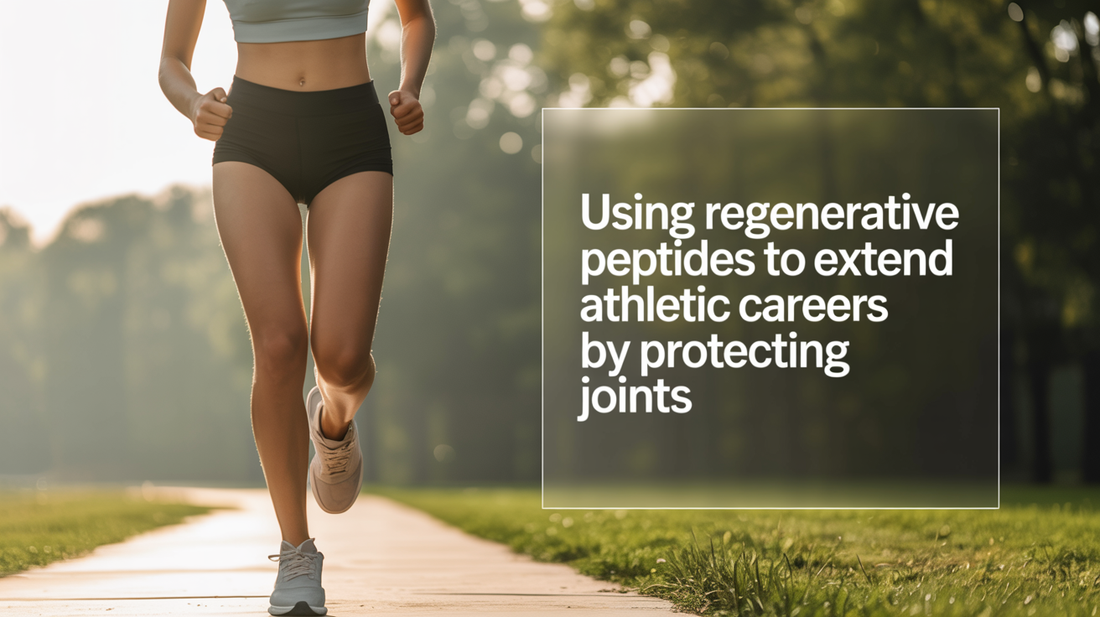
Using Regenerative Peptides to Extend Athletic Careers by Protecting Joints
Share
Regenerative peptide therapy offers athletes a way to maintain joint health, reduce wear-and-tear injuries, and extend their competitive years. By protecting connective tissues and supporting long-term mobility, these therapies help athletes not only recover from stress but also safeguard their performance longevity.
The Challenge of Joint Longevity in Sports
Athletes place enormous demands on their joints, especially in high-impact sports or repetitive training. Over time, this stress can accelerate wear on cartilage, ligaments, and tendons, making them more vulnerable to chronic injuries. The repetitive nature of training, whether it’s running countless miles, performing explosive jumps, or engaging in strength sessions, gradually chips away at the integrity of these tissues. What begins as mild stiffness or soreness can evolve into persistent problems that shorten careers.
- Cartilage breakdown leads to stiffness and pain, limiting range of motion and making it harder to recover between training cycles.
- Tendon and ligament strain weakens structural support, increasing injury risk and slowing rehabilitation when injuries do occur.
- Inflammation and micro-tears accumulate from repeated training cycles, delaying recovery and contributing to chronic soreness.
- Loss of mobility makes it harder to perform explosive or precise movements, cutting athletic careers short.
- Cumulative stress on joints often creates a domino effect, where one weakness leads to compensatory movements that overload other areas of the body.
- Psychological setbacks emerge when athletes face repeated downtime, eroding confidence and forcing adjustments to their routines.
These factors often force athletes into early retirement, not because of diminished skill or conditioning, but due to joint deterioration. For professionals who rely on consistent performance, even small reductions in joint health can mean the difference between competing at the highest level and being sidelined. Recreational athletes may also find their ability to stay active into later life compromised when joints are not adequately protected.
How Regenerative Peptides Protect Joints
Peptides such as BPC-157 and TB-500 are gaining attention for their ability to protect and restore joint tissues. By acting at the cellular level, they support repair mechanisms that keep joints resilient even under high athletic demands. In addition to addressing damage, they provide ongoing reinforcement to withstand the constant strain of rigorous training.
✅ Stimulate collagen production – strengthens cartilage, tendons, and ligaments for better durability.
✅ Promote angiogenesis (new blood vessel growth) – improves nutrient delivery to joint tissues, ensuring optimal recovery environments.
✅ Reduce inflammation – lessens joint swelling and stiffness, allowing smoother recovery and minimizing setbacks.
✅ Accelerate repair of micro-tears – helps connective tissues withstand repeated stress and recover more fully.
✅ Support long-term structural integrity – preserves joint function across years of training and competition.
✅ Enhance joint resilience – encourages adaptability so athletes can meet higher training demands without breaking down.
By protecting these crucial tissues, peptides help athletes maintain peak performance while reducing the likelihood of career-ending joint injuries. Their role is not just in recovery but in proactively extending athletic potential.
Benefits for Athletes Seeking Career Longevity
The application of regenerative peptides offers both short-term relief and long-term preservation of joint health. Athletes who incorporate such therapies often experience measurable improvements in mobility, fewer interruptions from nagging injuries, and a renewed confidence in their ability to push limits.
- Fewer recurring injuries – joints remain stable even under repetitive load, reducing forced rest periods.
- Extended career span – athletes can train and compete longer without chronic pain.
- Improved mobility – smoother, more fluid joint function supports high-level performance.
- Confidence in training – reduced injury risk allows athletes to push their limits safely.
- Sustainable recovery cycles – quicker turnaround between sessions with less downtime.
- Greater adaptability – the body can adjust to new demands with reduced risk of overuse breakdowns.
These advantages make peptide therapy a potential game-changer for athletes aiming to extend their careers without sacrificing joint health. When combined with proper training, nutrition, and rest, they can form the cornerstone of a sustainable long-term athletic strategy.
Safety and Considerations
Like any therapeutic approach, regenerative peptides should be used responsibly:
- Medical guidance is essential – protocols must be tailored to individual needs.
- Quality sourcing matters – peptides should come from trusted providers.
- Monitoring is recommended – tracking inflammation, mobility, and tissue recovery ensures effective outcomes.
- Personalized adaptation – athletes should adjust dosage and usage in line with their workload and overall health status.
The Future of Athletic Longevity
As athletes look for ways to stay competitive longer, regenerative peptides are emerging as a cornerstone of joint protection. By addressing the root causes of joint deterioration, these therapies may allow professionals and active adults alike to perform at their best well into later stages of their careers. With ongoing research and more refined protocols, the use of peptides is likely to become even more accessible and effective in supporting longevity.
Athletic skill and determination may set performance levels, but joint health often determines career length. With regenerative peptides, athletes now have an opportunity to keep both aligned for the long run, ensuring that talent and dedication are not cut short by preventable joint decline.
